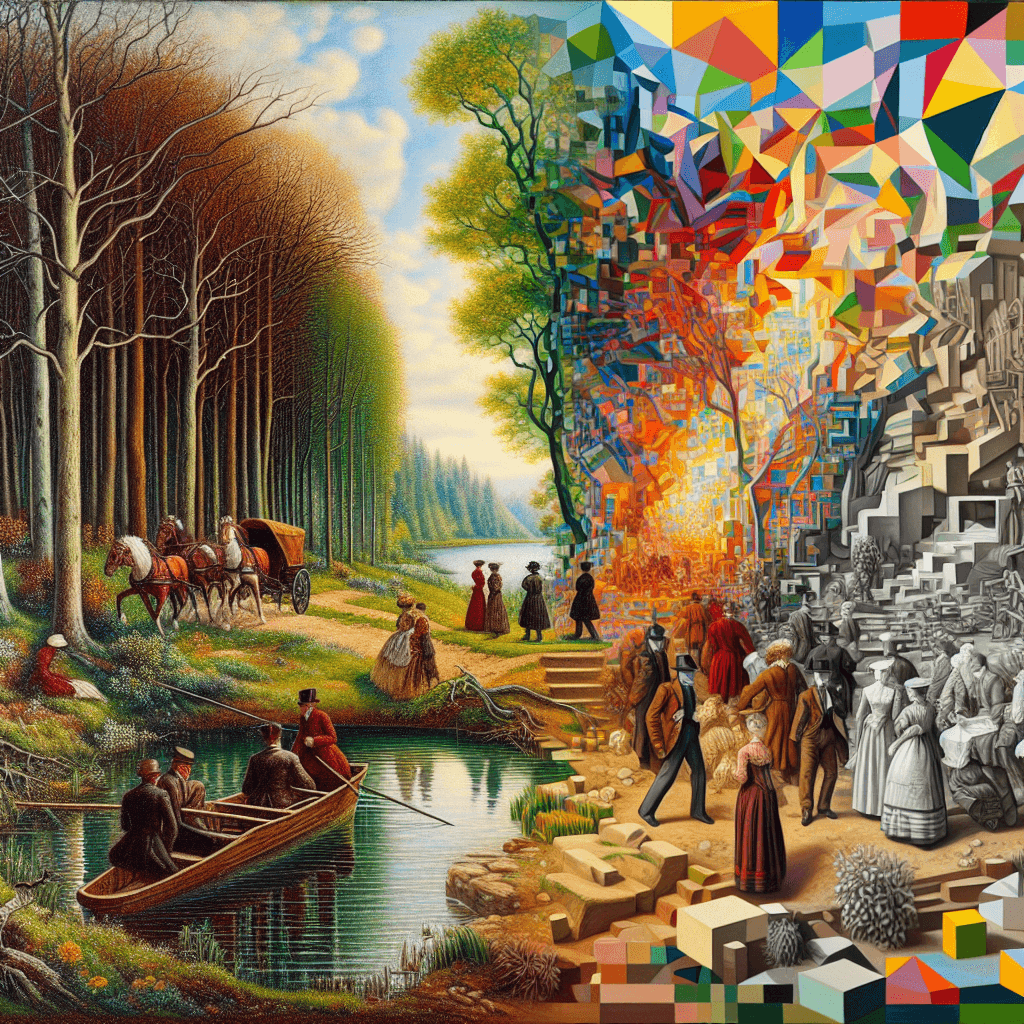Exploring Art Styles: Understanding Realism to Abstract Art
TL;DRThis article delves into the diverse world of art styles, tracing the journey from Realism to Abstract Art. It is designed to be a comprehensive guide for those looking to understand the nuances of different art movements and how they evolved over time. The piece will cover major styles such as Realism, Impressionism, Post-Impressionism, Expressionism, Cubism, Surrealism, and Abstract Art, providing insights into their characteristics, key figures, and societal impact.

Table of Contents
The Evolution of Art Styles
Realism
Definition and CharacteristicsRealism emerged in the mid-19th century as a reaction against the exaggerated emotions and drama of Romanticism. It sought to depict subjects as they were, often focusing on everyday life and ordinary people. Realists paid close attention to detail and aimed for accuracy in texture, color, and lighting.
Key FiguresGustave Courbet and Jean-François Millet were prominent Realist artists who showcased the unvarnished truth of the working class and rural life.
Impressionism
Definition and CharacteristicsImpressionism, which originated in France in the late 19th century, marked a departure from Realism. Impressionists aimed to capture the fleeting effects of light and color, often painting en plein air (outdoors). Their brushwork was loose and quick, creating a sense of movement and spontaneity.
Key FiguresClaude Monet and Edgar Degas were among the leading Impressionists, known for their vibrant landscapes and scenes of contemporary life.
Post-Impressionism
Definition and CharacteristicsPost-Impressionism followed Impressionism and was not a cohesive style but rather a range of individual responses to the limitations of Impressionism. Post-Impressionists continued to use vivid colors and real-life subject matter but with a greater emphasis on geometric forms and unnatural color to express emotion.
Key FiguresVincent van Gogh and Paul Cézanne were notable Post-Impressionists whose works laid the groundwork for the transition to 20th-century modern art.
Expressionism
Definition and CharacteristicsExpressionism arose in the early 20th century, primarily in Germany. Expressionists sought to convey emotional experience rather than physical reality. They used bold colors, distorted forms, and dramatic brushstrokes to evoke mood and feeling.
Key FiguresEdvard Munch and Ernst Ludwig Kirchner were significant Expressionist artists whose works often explored themes of anxiety and human psyche.
Cubism
Definition and CharacteristicsCubism, developed by Pablo Picasso and Georges Braque, was revolutionary in its approach to representing reality. Cubist artists fragmented objects into geometric shapes and presented them from multiple angles simultaneously, challenging traditional perspectives.
Key FiguresPablo Picasso and Georges Braque are synonymous with Cubism, and their innovative techniques had a profound impact on the direction of modern art.
Surrealism
Definition and CharacteristicsSurrealism emerged in the 1920s, inspired by the theories of Sigmund Freud. Surrealists explored the world of dreams and the unconscious mind, creating bizarre and illogical scenes. They employed a variety of techniques, including automatism and the juxtaposition of incongruent elements.
Key FiguresSalvador Dalí and René Magritte are two of the most iconic Surrealist artists, known for their dreamlike imagery and symbolic content.
Abstract Art
Definition and CharacteristicsAbstract Art represents a significant move away from the depiction of recognizable objects and focuses instead on the use of color, form, and line to create compositions independent of visual references in the world. Abstract artists express their ideas through a visual language of shape, form, color, and line.
Key FiguresWassily Kandinsky and Piet Mondrian were pioneers of Abstract Art, exploring the potential of non-representational painting and the emotional power of color and composition.
Comparing Art Styles
Each art style has its own distinct characteristics, yet they are all connected by the thread of human creativity. Realism focuses on accurate depictions, while Impressionism captures the impression of a moment. Post-Impressionism emphasizes personal expression, Expressionism conveys emotional experience, and Cubism breaks down objects into abstract forms. Surrealism delves into the unconscious, and Abstract Art abandons representation altogether.
The Impact of Art Movements on Society
Art movements are not just about aesthetics; they often reflect and influence societal changes. Realism brought attention to the lives of the working class, Impressionism broke free from artistic conventions, and Post-Impressionism paved the way for modern art. Expressionism expressed inner turmoil, Cubism redefined perspective, Surrealism unlocked the unconscious, and Abstract Art challenged the very notion of art.
Conclusion
From Realism to Abstract Art, each style has contributed uniquely to the tapestry of art history. Understanding these art movements not only enriches our appreciation of art but also offers insights into the cultural and historical contexts from which they emerged. As we continue to explore and interpret art, we gain a deeper understanding of the human experience and the ever-evolving nature of creativity.



